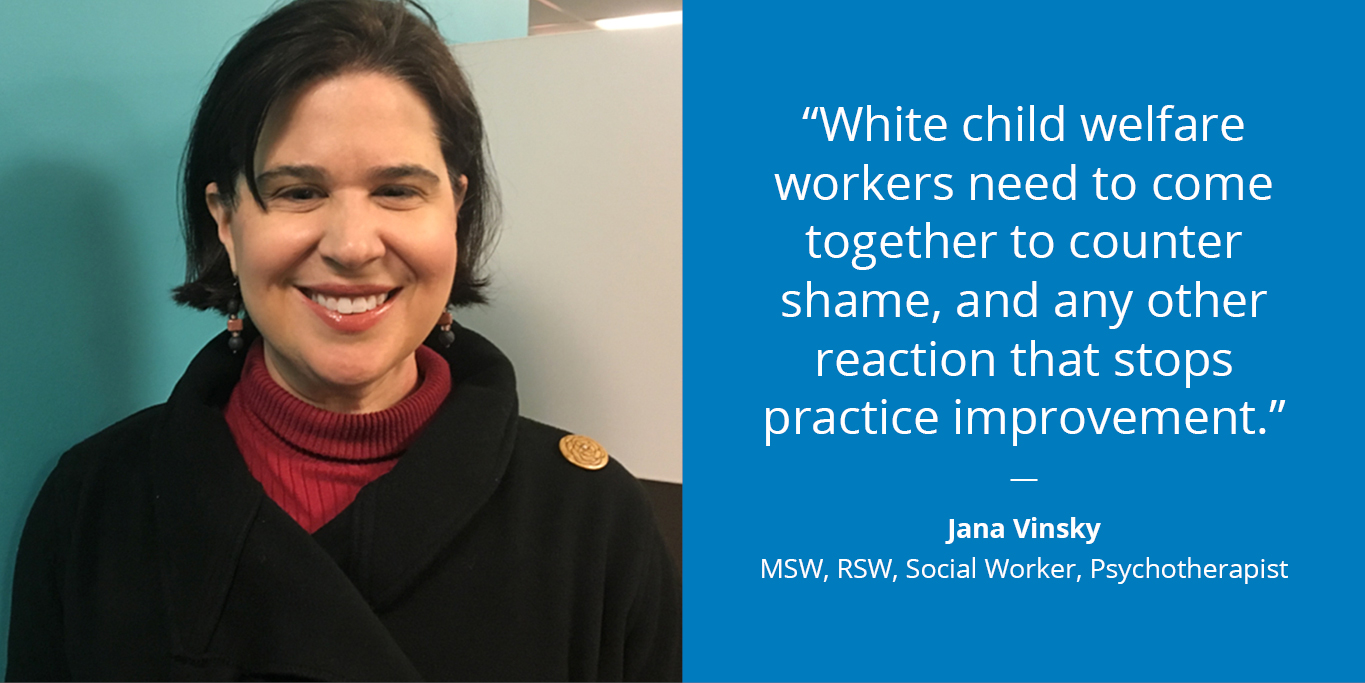
“What’s even worse than our white guilt is our shame” is the feedback I heard from white child welfare workers after I published my article “White Guilt: How to move into responsibility for white child welfare workers.”
As child welfare workers, making mistakes in our practice can feel shameful and something we wish to hide. When some of us who are white make mistakes regarding race, this shame can be compounded.
The child welfare sector has seen resistance from white child welfare workers when attempts have been made to address race. The roots of our resistance have been multiple and complex. While it is definitely true that white child welfare workers attempt to stop race-based initiatives due to racism, it is my belief (after speaking with many white child welfare workers behind closed doors) that some of these same workers may also be defending against shame, in ways that do not look like shame. Shame is one of a multitude of factors that can stop a white child welfare worker from addressing racism. The Compass of Shame model by Dr. Donald Nathanson can help us understand some of the defenses of shame. These include withdrawal, avoidance, attack on other, and attack on self.
What is shame?
Shame is an extremely difficult emotion based on judgmental thought.
Guilt is feeling bad about what we’ve done. Shame is feeling bad about who we are. To move into guilt from shame can be an accomplishment: we recognize that we have done wrong and can make amends. Shame can spiral us into feeling worthless and can influence us to become immobilized (more on how shame operates here). Yet many white workers have not allowed shame, or any other reaction, to stop them from addressing racism in their practice and the systems they work within.
As workers, when we conceal our embarrassing moves and prevent a view of our ignorance and mistakes, we are often attempting to reduce the anxiety of being deemed imperfect, including from within. Shame is a natural reaction to falling short of our own expectations and can be an indicator of our values not being realized. As white child welfare workers, our self-opinion (including a high image of ourselves due to histories of white benevolence) can be threatened when learning about our participation in racism (see my previous articles here and here, and Robin DiAngelo here). We often point to shame regarding white people’s common need to be seen as “good”. Many white child welfare workers tell me they shut down and hide in fear when the topic of race is mentioned, to not confront their practice as being possibly racist, and to not be judged by others as “bad”.
Because of this anxiety and fear, we often require “politeness” to the point of silence about our practice. White supervisors have told me on numerous occasions that they fear white workers’ reactions to having their racism pointed out. I have also heard from many racialized people that it’s just not worth addressing the racism of white people. High levels of ignorance, an unwillingness to take responsibility, and potential retaliation when white peoples’ egos get threatened are some of the reasons people do not address the everyday racism of white workers.
Working together to counter shame
Together we can come to understand that our mistake-making is also systemic, since we are situated within ideological and structural processes of racism (see Anti-Black Racism, Bio-Power, and Governmentality: Deconstructing the Suffering of Black Families Involved with Child Welfare). In this way we can give up the fear of being the bad apple, knowing that the tree and soil is at root of the many mistakes we make. In centralizing race in our understanding of all aspects of practice, we can move together collectively to address the structural and ideological processes that shape and keep our racist practice in place. Collectively we can support our sector’s urgent efforts to improve practice.
For practice improvement to occur, we must be able to learn through multiple forms of feedback. One important form of feedback can be creating practice review settings for supervision, teams, and peer coaching groups that deem the catching of oppressive ideas and mistakes as a strength, and a path towards a critical reflective practice that can help prevent substandard service delivery (see Jan Fook here). Although it can be difficult to have our mistakes known by others, there are severe consequences if we cannot tolerate the discomfort required to discuss our mistakes with our supervisors and colleagues.
For practice review settings to be successful there needs to be a communication climate that is non-judgmental, where white people do not claim superiority above one another for being less oppressive, and where connection is maintained; generously meeting people where they are at. This includes building supportive and various forms of supervision that are mistake friendly, where the fear of blame and punishment is minimized. Only then can we cultivate a learning environment that can help us to examine where we need to improve practice. We can then change our view of shame to be that of an indicator, showing we are becoming more conscious; we will be more mindful next time. We can simultaneously focus on a deeper feeling of gratification, knowing we will be able to live out our values in our future practice, through enduring this difficult learning process.
Ten ways white child welfare workers can address their shame
1) Get in touch with what’s underneath our reactions of anger, blame, dismissal, and withdrawal in addressing racism in child welfare. There can be deeper forces like fear, grief, ignorance, hatred, as well as other forms of white supremacy informing our reactions, and hence, preventing us from taking ethical responsibility. It’s also our job to become emotionally responsible in order to meet the expectations and standards of practice, and to not compromise the sector’s efforts for practice improvement. Let’s own our individual and collective emotionality, including shame.
2) Understand shame as a potentially positive catalyst to change our behavior, perhaps we can view this shame as a “healthy shame”. Let’s befriend shame but not get mired in it. Maybe it’s not such a bad thing to feel a little collective shame for the current outcomes of our sector?
3) Let’s work on our personal relationship to shame, including shame’s connection to trauma. Shame helps us monitor our behaviour in order to stay interdependent with others. This helps us ward off fear of isolation, which could mean social and sometimes even physical death. Sensitivity to shame can be a survival reaction embedded in our nervous system, which can be affected by trauma and attachment difficulties, including that which are systemic.
It’s important we all do our own healing to make us less prone to shame in learning about racism in our practice. More on trauma and our nervous system here.
4) Practice restorative justice rather than punishment. This supports a non-shaming approach to mistake-making that restores connection and prevents the furthering of shame.
5) Become skillful at feedback. In order to better receive feedback on our imperfect practice, it’s important we create an inner experience of safety. We can do this by taking a step back and non-judgmentally observing our shame reactions; experiencing the sensations shame produces in our body; and feeling the feelings of shame without pushing them away, and then simply letting them go. We can also use compassionate self-talk to reassure ourselves that we won’t self-abandon, no matter what mistakes we make. We can also get in touch with a sense of our common humanity, knowing we’re not alone in mistake-making (see Kristen Neff). It’s important we build such inner safety, so we don’t require racialized people to build it for us externally, at the expense of their voice i.e., by asking for “safe spaces” or better expressions of feedback towards us.
We can also enhance our capacity to receive feedback through reading the book, “Thanks for the Feedback: The Science and Art of Receiving Feedback Well” by Stone and Heen. And we can become knowledgeable on how “face needs” are involved in feedback. For instance, a common difficulty in confronting our mistakes is that our “face needs” can be threatened. This includes the need to see oneself as competent, liked, and autonomous (see Politeness Theory).
6) Follow Brené Brown’s suggestion to practice vulnerability and courage. We can discuss our shame with one another and build our shame resilience together (more here and here). We can learn how marginalization generates shame (here and here). We can take Matthew Modrcin’s course to understand shame and how to work with it in practice. Additionally, we can review the resources list included below to learn how to work with our shame.
7) Understand shame is in the body. When in a shame state, we can come back to our centre by altering our physiology through movement such as exercise, or even in changing our posture and body expression. Check out insights from Somatic therapies here and here.
8) Shame is a self-focused emotion. Shift the focus away from yourself and centre on contributing to others. Empathy and attunement often get curtailed when we are too self-focused. Engage in self-practice review with the intention of coming back into connection, contribution, and presence with others. Don’t let the self get in the way.
9) Flawed practice doesn’t make the practitioner flawed. Remember, we’re only some knowledge and skills away from better practice. Keep learning. Support race-based initiatives in child welfare to help all of us meet the expectations and standards for good practice. Concurrently, let’s remember to appreciate ourselves for the good work we’re already doing. Don’t allow our mistakes to be the single story. Remember to narrate positive practice moments as well. We can also do this in our personal life, such as in our roles as mother, father, aunt, uncle, sister, brother, friend, partner, etc. Shame is produced by expectations not being met. Take every opportunity to practice self-appreciation and to build shame resilience.
10) Understand that racism in our practice is not only personal but also systemic. It is inevitable that racism will seep into our consciousness. For this reason, we need to be intentional and deliberate to not reproduce racism in our work. We do this through ongoing critical reflective practice. Check out the reflection tools on “systemic chatter”, to get a sense of how dominant systemic narratives are always trying to inform our thinking, feeling, and body responses, and thus our decision-making. Systemic chatter is historical, structural, and ideological. It creates us as practitioners as we create it. Our job is to catch it, so it doesn’t get into our work. Our job is also to unearth and promote narratives that counter oppression. Learn more here. In this way, we can become responsible for addressing racism in ourselves and our child welfare practice, and thus not allow shame to be a defense.
10 additional resources on how to address our shame:
